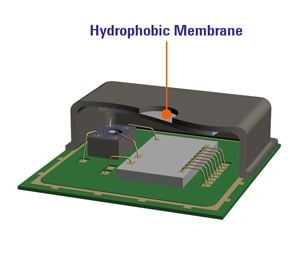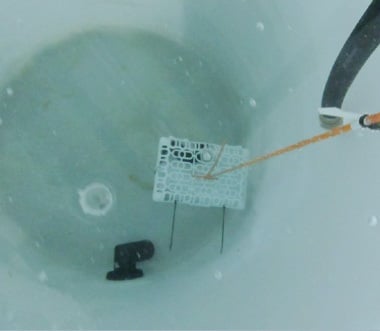Affordable and miniaturized gas sensors are becoming increasingly popular and more common in everyday applications, including smart buildings and smart homes. What happens when end users want to make air quality measurements in systems and locations where the sensor can be exposed to dust and liquids, such as in kitchens or bathrooms? For standard electronic devices, one solution is to put everything in a water- or dustproof enclosure. When that is not possible, there are a wide variety of conformal materials available to coat PCB and ensure protection from water and dust. However, a gas sensor cannot be sealed off from the environment or coated with an inert material, as the sensor has to remain open to the environment. The solution is to add a hydrophobic membrane at either the sensor package or system level.
A hydrophobic membrane is a material, such as a polytetrafluoroethylene (PTFE), which is impermeable to water and other liquids but allows gases to pass through. Such materials have become extremely popular in lightweight outdoor apparel such as Gore-Tex®. Industrial versions of these materials are specifically designed to protect all sorts of electronic equipment from dust and water and can be successfully integrated into sensor packaging with advanced manufacturing technology. These industrial membrane materials are specifically designed and chosen with pore sizes that allow target gases to pass unimpeded, while providing outstanding protection against liquids (see Figure 1).
One example of such an implementation is the ZMOD4410AI3, an air quality sensor designed with an integrated hydrophobic membrane to protect the sensor from harsh environments. Having the water and dust protection directly implemented in the sensor package makes the sensor easy to use, especially in kitchen, bathroom and even outdoor applications.

Figure 1. Cutaway of ZMOD4410AI3 waterproof package
However, how can a customer or user understand the limits of the technology? How does a customer know if the sensor protection is adequate for the intended application and use case? Fortunately, there are well-established and recognized standards (IEC 60529 / EN 60529) available to define requirements and testing for certification of the degree of water- and dustproofing for a given device or design. Devices which have been characterized according to these standards carry a designation in the form of IPxy, where IP stands for ingress protection, x indicates the degree of dust protection and y indicates the degree of water protection. The most common standard for consumer and industrial products is IP67 (see Figure 2).

Figure 2. ZMOD4410AI3 submersed for third party in IP67 third party IP tank
A dust protection level of 6 indicates that the device is dust tight and requires test under vacuum for 8 hours followed by an inspection to ensure that dust cannot penetrate the device. A water protection level of 7 indicates there is no harmful ingress of water when the device is submerged to one meter for 30 minutes. A device which is rated IP67, such as the ZMOD4410AI3, is generally considered extremely water and dust tolerant and suitable for use in a wide range of consumer and industrial devices. By selecting a gas sensor rated IP67, customers manufacturing equipment where the sensor is exposed to water and dust can rest assured that the sensor is well protected, making the design and development process much simpler.
Please visit the ZMOD4410 product page for more information on the waterproof package, including dev kits, samples and technical documentation.
